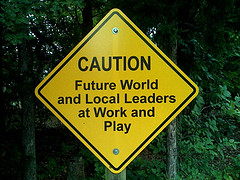The Power of Play
The Workshop, a creative workspace in Louisville, KY, is marketed with the tagline: “the power of play at work.” That tagline captures perfectly my belief that we need to “play” more to improve our performance. It is through “play” that we practice and perfect our skills.
 The folks at The Wunderlin Company have long used experiential activities as effective tools for changing behaviors. Since 1995 we have increasingly used simulations because these experiences offer such rich learning opportunities for our clients.
The folks at The Wunderlin Company have long used experiential activities as effective tools for changing behaviors. Since 1995 we have increasingly used simulations because these experiences offer such rich learning opportunities for our clients.
In this issue of “Changing Times,” we’ll take a look at how simulation games change the way people do their work. Let us know if you find something in this issue that captures your imagination as a potential tool for improving the way you work. We’ll be glad to elaborate!
An Interview with Thiagi
Simulations: Learning from Behavior
Karen recently had the opportunity to work with Thiagi, game creator extraordinaire. They spent the day looking at Karen’s new simulation game and talking in general about using simulations. Reproduced here are some of his observations about the value of simulations.
“The best way to learn something is ‘on the job,’ but that can be very dangerous and very costly,” cautions Sivasailam “Thiagi” Thiagarajan, Ph.D., a highly regarded simulation game creator, trainer, and educator. “The next best thing is simulations.”
And simulations are something that Thiagi knows a lot about. He is a much-published author on the subject and the creator of BARNGA, a globally recognized, cross-cultural communication game that has been translated into seven languages.
“Everyone learns through simulations — from the most primitive of societies to the most sophisticated corporations.” It is an intrinsic way of learning. He points out that as children play, they learn a lot through simulation — whether it’s playing house or playing dress up. Adults learn this way too. “Play,” he explains, “is one of the most powerful and least used strategies for improving human performance.”
According to Thiagi, using simulations is an ancient form of teaching. “The game of chess is one of the earliest simulation games that still exist today. And during World War I, a number of war games were developed to teach soldiers military tactics.” Thiagi has seen the use of simulations in the corporate world grow rapidly in the last two decades.
“People do not learn from the actual simulation, rather they learn from reflecting on how they behaved during it,” explains Thiagi. “Simulations don’t distort a person’s behavior, rather they hold it up as a mirror to it. And in some cases, it’s a magnified mirror.”
Providing the Perfect Opportunity to Practice
In a recent article in Fast Company magazine entitled “Game Over,” Peter Carbonara reports that simulations are “a tool sweeping business.” He notes that “people are making tougher decisions in less time with fewer resources. Even as competition gets more complex, the margin for error shrinks. Being great at business today requires something few people have — opportunities to practice. That’s the real value of simulations.”
He points out that “actors, athletes, and musicians wouldn’t dream of performing without practicing. But where and when do businesspeople practice? Most of the time they attend the school of hard knocks — encountering new situations, making mistakes, learning from what goes wrong. But learning from real mistakes gets expensive — both for the company and the people who make them. Simulations create “virtual practice fields” that allow people and teams to test their assumptions and experiment with new ideas without having to suffer financial reversals or career setbacks.
Carbonara says that in order to work, simulations need to follow a few basic rules. “First, they have to feel real. Second, the exercise should focus on well-defined choices. And third, the players should be able to see a direct connection between their decisions and the company’s performance in the market.” He points out that “one of the most powerful virtues of simulation is that it compresses the time between action and outcomes.” Carbonara concludes by offering “best practices on how to practice:”
- Never forget the point of practicing is to learn how to get better.
- Good practices force people out of their existing mindsets and routines.
- The practice works best when it puts people on the spot — that is,
when it requires them to take decisive action.
Mark Chussel, co-founder of Advanced Competitive Strategies, says in the article that “the ultimate result of good practice is to develop leadership qualities that are all-too-rare in business today: the courage and confidence to take risks.”
A Good Debriefing Session Makes a Great Difference
What happens if participants in a simulation have a great time — but learn nothing? Worse yet, what if some participants become confused, frustrated and upset?
One role of a good facilitator is to conduct a debriefing which connects simulation experiences to real-world situations so that participants learn how to productively change their behavior.
In the debriefing session, the facilitator allows the participants to talk about how they feel, getting strong emotions off their chests. Then they help the group collect data about what actually happened during the simulation.
The facilitator helps them understand that the activity is a metaphor and draws from them real-world analogies. The participants can then apply their insights to new contexts.
That’s when the real learning takes place! Participants define how they will change their real-world behavior as a result of the insights gained from the simulation.
A well-orchestrated debrief makes the difference between a fun day playing games and a fun day where teams gain new insight into improving their effectiveness.
Virtual Gourmet: Building Sandwiches; Building Teams
In a simulation, participants experience a situation in a “neutral” form, which enables them to see and learn from what’s happening, and to experiment with effective responses. Virtual Gourmet, a simulation developed by Doug Silsbee, is a good example of this and one that The Wunderlin Company has used several times with great success.
A major global bank was rolling out a new program that involved “virtual teams.” Senior account managers and technical experts around the globe were newly organized in a highly flexible structure to coordinate sales strategy and technical solutions for major global clients. For each client, the “team” membership and responsibilities were different. A simulation was perfect for identifying the skills and behaviors required by this complex, decentralized and ambiguous environment.
The bank’s new initiative required the managers to:
- assemble a coherent picture of customer needs from highly fragmented information;
- identify specialist and technical resources within a complex system, and access needed information;
- coordinate efforts of team members across time and space; and
- maintain a clear focus on the desired results while overcoming organizational “noise” and chaos.
A good simulation has a structure, metaphorical to the real business situation, that includes an enticing challenge and a satisfying resolution. In the case of Virtual Gourmet, the enticing challenge is creating gourmet sandwiches. The satisfying resolution is a meal for each participant if they effectively apply the required skills. Participants work in geographic “regions” (i.e., separate rooms), communicating via phone.
Participants play roles and have limited information about customers and team structure. Ingredients such as smoked turkey, gorgonzola cheese, and kaiser rolls are located throughout the simulation world, most often other than where they will actually be needed for sandwich construction. The challenge is to assemble an integrated picture of the desires of each team’s customers, identify the ingredients that are needed and available, arrange to have them delivered to where they are needed, build the actual sandwiches, and deliver them to the dining room. Successful resolution of the challenge provides a delicious sandwich for each participant (and consultant)!
After dining, the client group analyzes the simulation and engages in a frank discussion of related business issues. Beginning with the voices of real sandwich “customers,” the group then talks about how they sought to identify and meet customer needs, and the consequences of the choices they made. The review winds up with a discussion of the strategies needed to be effective in actual business situations. The clients who have tried this simulation have found it fulfilling on a number of levels, feeding both the body and spirit!
Aha…Get it with K’nections
It’s 9:30 p.m. You have been locked in the team war room since 8 a.m., but the team still hasn’t been able to agree on what your product’s storage capacity will be. Finance has been calling every hour looking for your decision because they can’t do their work until the bill of materials is complete. And your marketing members have been on the West Coast all week doing consumer research when they are needed here with the team. What will you tell your boss at the milestone review tomorrow?
Teams who practice the decision-making and team skills that they face every day at work are far more likely to succeed in the real business world. That’s the theory behind K’nections, a new simulation created by Karen Wunderlin.
K’nections is a simulation that creates change by allowing participants to internalize the experience of effective teams.
A number of international corporations now use K’nections to launch new teams down a positive path and are doing so with remarkable results. Brown-Forman is one such company. “We used K’nections to infuse our B.L.A.S.T. teams with the knowledge and spirit of effective team decision making and found it to be a very powerful learning experience.” relates Phil Lichtenfels, vice president of leadership and development. He explains, “In one day these teams previewed the roller coaster they would be on for the next several months. The insights they gained and the changes they made to how they were doing their work contributed significantly to their ultimate success.”
Here’s How it Works
Teams of 4-8 individuals research, specify, design, build, demonstrate and market a meeting-efficiency product that is built of K’nex, a construction toy. The team must factor in such variables as cost, time to market, concurrent work, team effectiveness, and market success.
Participants have specific process and function roles on the team (i.e., timekeeper and financial). The teams work their way through five simulation periods completing specific tasks during each phase. During the final period, the entire simulation group convenes to present their marketing launch presentations and to demonstrate their products. The energy, fun, humor, and enthusiasm of this time reward the groups for their hard work and enable them to benchmark their results.
Every decision the team makes has a price, cost, market-share or market-size implication, which is ultimately measured as the profitability of their product. During the debrief, participants reflect on their experiences and identify ways to apply that learning to their work. The day is filled with lots of “Aha!”s as the teams “get it with K’nections.”


Leave a Reply